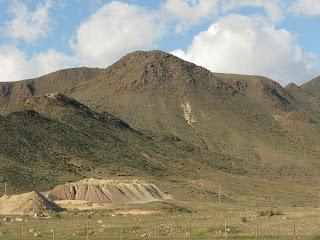The campsite is hardly visible from the road – here is a view from the rambla which runs down past the campsite to the sea.

The campsite is surrounded by green woolly volcanic hills (which are normally much less green and woolly and more scrubby)

On the coast at the end of the rambla is the quiet unspoilt tiny hamlet of Los Escullos and a well restored 18th century gun battery

The rocks on the coast are unusual – the colour and texture of frothy capuccino



with the occasional crater like hole

Some interesting natural rock sculpture on the beach:

Walking south towards San Jose there are fossil dunes
 Here are some shell fossils
Here are some shell fossils
The nearest (very small) general store is about 3k north east along the coast at La Isleta, a small unspoilt fishing village with some good bars and restaurants.

The first time we walked into the village there was a drunk sitting outside the shop with a dustbin on his head!
There is a very pretty coast path to La Isleta which we walked often and where we saw new flowers each time



and a wonderful big palm tree

The Cabo de Gata area is a joy for walkers. There are paths everywhere and most routes are well signed. We walked up the rambla and followed some very large animal tracks part of the way

to find the volcanic crater,

a beautiful peaceful place full of history with abandoned farms and prickly pears.

On the route we passed this old wreck of a car which passing walkers had filled with stones from the rambla

and this rock which looks like a face

A different rambla took us past hills of terraced walls and prickly pears

to El Pozo where there was a beautifully restored aljibe (cistern) with a water wheel which had been in use until about 30 years ago.


One day we went to Rodalquilar to walk the Cerro del Cinto path which took us to the old gold mines

There were danger notices but nothing to stop you exploring

The rocks were amazing colours:

intense fiery reds, bright yellow, marbled meat colour and olive greeny grey
On this walk we had a great view over a huge fertile plain intensively farmed with both polytunnels and conventional fields and a massive reservoir

After two weeks of walking (whenever the weather permitted) we needed to move on, stock up with food and explore further north.
No comments:
Post a Comment